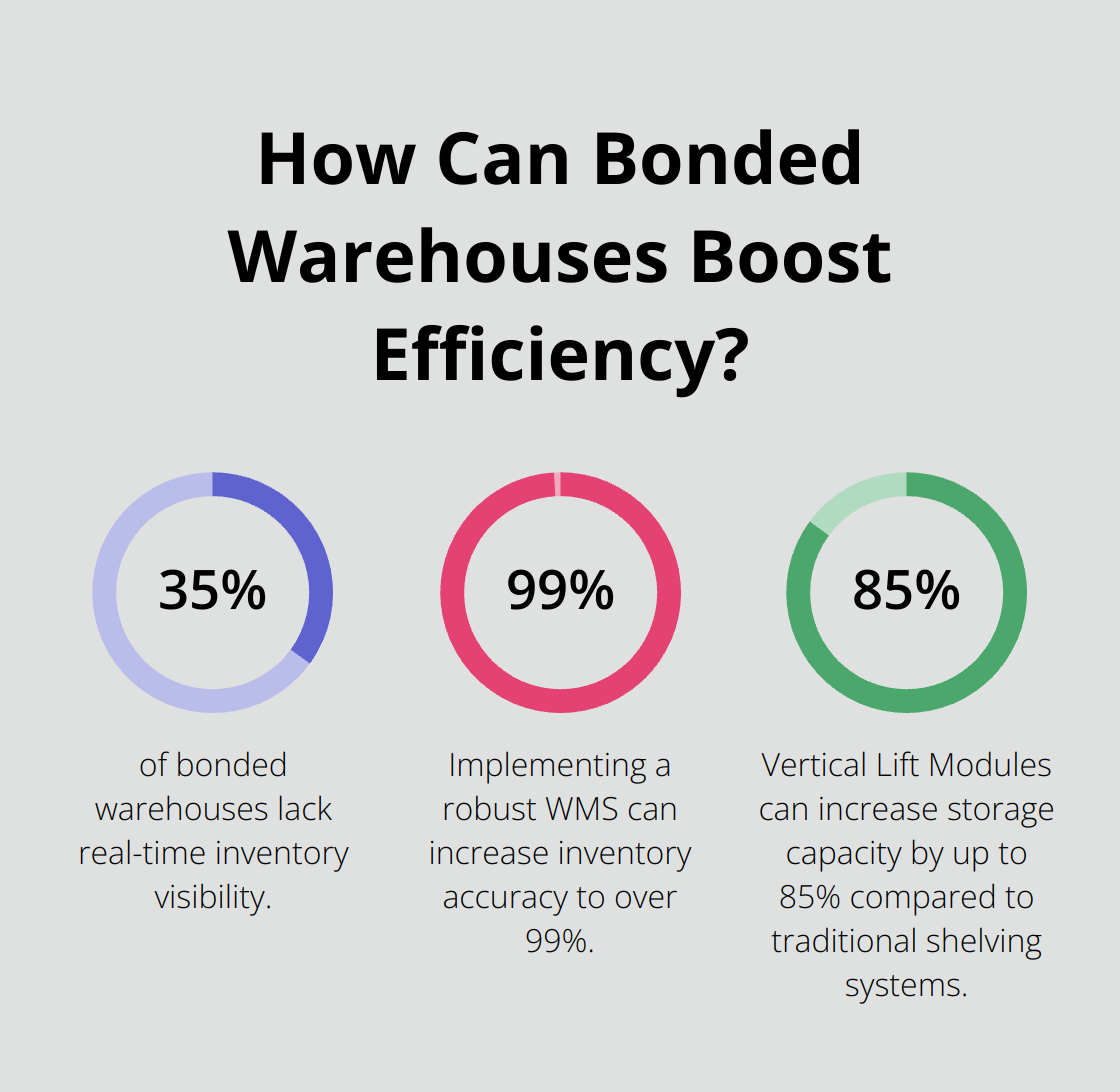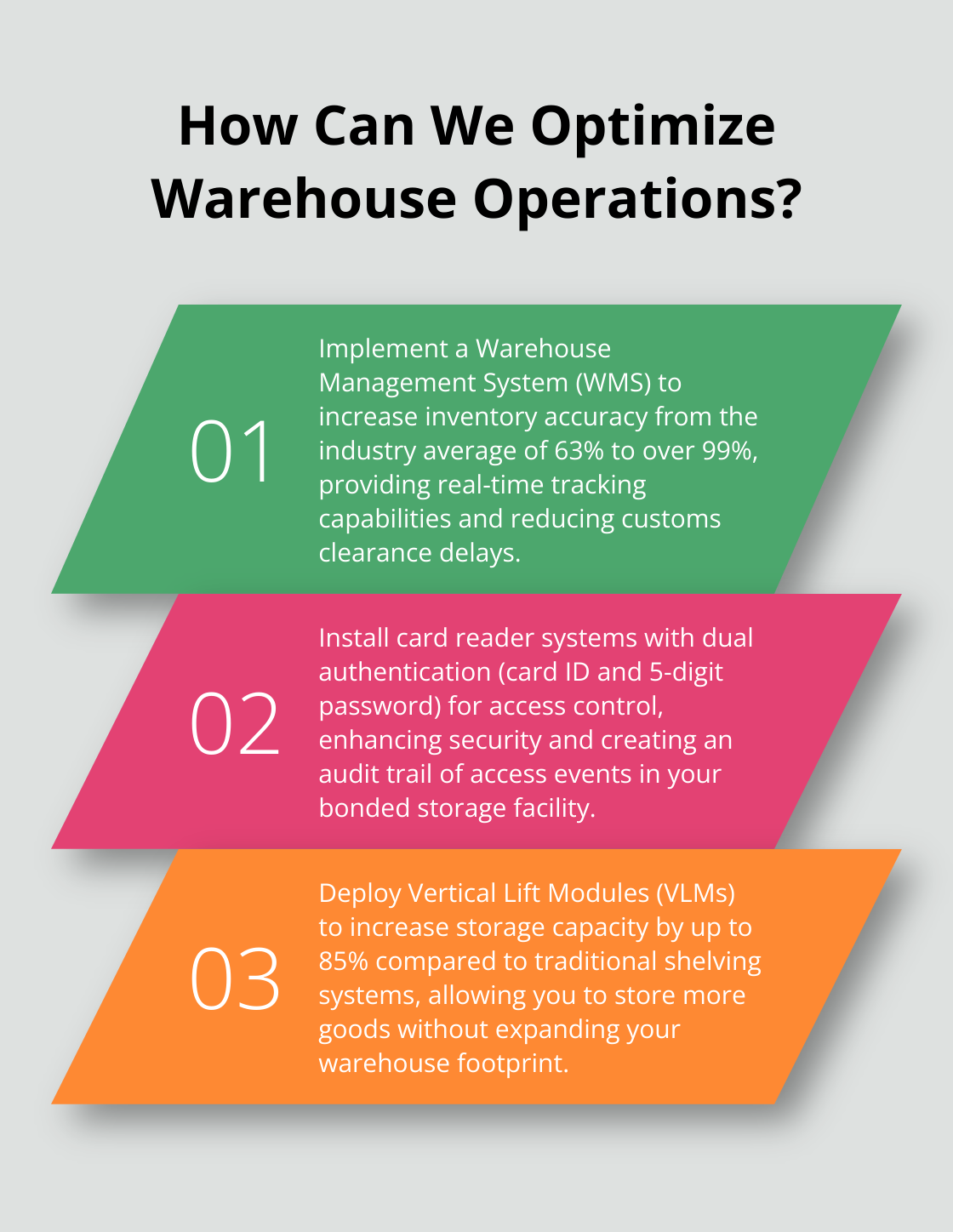Bonded storage facilities play a vital role in international trade, offering secure holding areas for goods awaiting customs clearance. However, managing these specialized warehouses comes with unique challenges that can impact efficiency and compliance.
At Outsource Equipment, we’ve seen how automated solutions are revolutionizing bonded storage operations. From inventory tracking to space optimization, technology is addressing key pain points and enhancing overall performance.
What Is Bonded Storage?
Bonded storage serves as a cornerstone of international trade. It provides a secure holding area for goods that have not yet cleared customs. This system allows businesses to defer payment of duties and taxes until products are ready for distribution, which can significantly improve cash flow management in global supply chains. By reducing delays associated with customs clearance, bonded warehouses contribute to smoother and faster movement of goods.
Types of Goods in Bonded Facilities
Bonded warehouses house a diverse array of items. High-value electronics, luxury goods, and even perishables like wine and spirits frequently occupy these spaces. Automotive parts, pharmaceuticals, and raw materials for manufacturing also find their place here.
Regulatory Requirements
Compliance stands at the forefront of bonded storage operations. Strict regulations govern these facilities, and for good reason. The World Customs Organization sets global standards, but each country enforces its own set of rules. In the U.S., for example, Customs and Border Protection licenses bonded warehouses and conducts regular audits to ensure adherence to regulations.
Documentation Challenges
One of the most significant hurdles in bonded storage involves documentation. Operators must meticulously track every item that enters or leaves the facility. This process extends beyond mere paperwork-it maintains the integrity of the supply chain and ensures correct duty payments upon goods release.
Security Measures
Security in bonded storage transcends traditional locks and cameras. It requires the creation of a tamper-proof environment. Many facilities now employ advanced access control systems, with biometric scanners becoming increasingly prevalent.
As we move forward, we’ll explore the key challenges that bonded storage operations face and how automated solutions address these issues head-on.
Navigating the Maze of Bonded Storage
Tracking inventory in bonded facilities presents a complex challenge. With constant movement of goods, accurate record-keeping becomes paramount. A study by the Global Trade Review revealed that 35% of bonded warehouses lack real-time inventory visibility. This opacity often results in costly errors and customs clearance delays.

Advanced Warehouse Management Systems (WMS) offer a solution to this problem. These systems provide real-time tracking capabilities, which significantly reduce discrepancies and improve overall inventory accuracy. The Warehouse Education and Research Council reports that implementing a robust WMS can increase inventory accuracy from an industry average of 63% to over 99%.
Fortifying the Fort
Security in bonded storage extends beyond theft prevention. It encompasses maintaining goods integrity and ensuring compliance with customs regulations. Access control forms a critical component of this security framework.
Modern facilities now adopt card reader systems that support card ID, 5-digit password, or a combination of both for access control and time attendance. These technologies enhance security and provide an audit trail of access events. A report by MarketsandMarkets projects the warehouse security systems market to grow to $8.2 billion by 2025, largely driven by the need for enhanced security in bonded facilities.
The Documentation Dilemma
Customs documentation and reporting remain among the most challenging aspects of bonded storage operations. The volume of paperwork required for each shipment can overwhelm operators. A single error can lead to significant delays and potential fines.
Automated documentation systems streamline this process. These systems can reduce processing time by up to 80% and minimize human errors. Moreover, they ensure compliance with ever-changing customs regulations across different jurisdictions.
Maximizing Space in a Finite World
Space utilization poses a constant challenge in bonded storage. The rise of e-commerce and global trade has pushed demand for storage space to an all-time high. A report by CBRE found that warehouse vacancy rates hit a record low of 3.6% in 2021, highlighting the urgent need for efficient space utilization.
Vertical storage solutions emerge as a game-changer in this arena. Vertical Lift Modules (VLMs) can increase storage capacity by up to 85% compared to traditional shelving systems. These systems transform warehouse operations, allowing businesses to store more goods in the same footprint.
As we address these challenges with innovative solutions, the next step involves exploring specific automated technologies that revolutionize bonded storage operations. Let’s examine how these cutting-edge solutions tackle the complexities of international trade logistics head-on.
How Automation Revolutionizes Bonded Storage
Space constraints in bonded facilities often lead to inefficient storage practices. Vertical Lift Modules (VLMs) offer a transformative solution. These automated systems increase storage density compared to traditional shelving. VLMs allow warehouses to store more goods without expanding their footprint.
Streamlining Operations with AGVs and Robotics
Automated Guided Vehicles (AGVs) and robotic systems transform material handling in bonded storage. These technologies reduce labor costs and minimize errors associated with manual processes.
Goods to Person robots retrieve items from storage and deliver them directly to packing stations. This eliminates the need for workers to navigate large warehouse spaces, significantly reducing picking times and improving accuracy.
Real-Time Inventory Management
Accurate inventory tracking is essential in bonded storage. Advanced Warehouse Management Systems (WMS) provide real-time visibility into stock levels, locations, and movements.
WMS integrates seamlessly with VLMs and robotic systems, offering a comprehensive view of warehouse operations. This integration allows for precise inventory control, reducing discrepancies and streamlining customs reporting.
Enhancing Accuracy with RFID and Barcode Technology
RFID and barcode technologies play a key role in modern bonded storage facilities. These systems enable rapid and accurate tracking of goods throughout the storage and retrieval process.
Advanced RFID readers and barcode scanners ensure that every item is correctly identified and logged. This technology not only improves accuracy but also speeds up the customs clearance process.
High-Speed Sorting for Efficient Processing
Robotic sortation systems transform how bonded warehouses handle large volumes of goods. Advanced systems can process up to 10,000 items per hour (significantly outpacing manual sorting methods).
This high-speed capability is particularly valuable during peak periods or when dealing with time-sensitive shipments. Faster processing means quicker customs clearance and reduced storage times, leading to improved cash flow for importers.
Vertical Storage USA provides comprehensive support for implementing these automated solutions, from initial consultation to installation and ongoing maintenance. Their team ensures that each solution is tailored to the specific needs of your bonded storage facility, maximizing efficiency and compliance.
Final Thoughts
Bonded storage facilities face numerous challenges in today’s fast-paced global trade environment. Inventory management, security concerns, documentation complexities, and space constraints impact operational efficiency and compliance. However, automated solutions have ushered in a new era for bonded warehouses, allowing operators to overcome these hurdles and unlock unprecedented levels of productivity.

The future of bonded storage facilities appears increasingly automated and data-driven as global trade continues to expand and evolve. We expect further innovations in this field, focusing on greater integration of AI and machine learning, predictive analytics for inventory management, and enhanced cybersecurity measures to protect sensitive trade data. These advancements will position bonded storage facilities at the forefront of international trade, ready to meet the challenges and opportunities of tomorrow.
Outsource Equipment offers comprehensive automated storage and retrieval solutions for businesses seeking to optimize their bonded storage operations. With a range of technologies designed to boost efficiency and reduce costs, Outsource Equipment stands ready to help warehouses navigate the complexities of modern trade logistics. Embracing automation in bonded storage is not just a competitive advantage-it’s becoming a necessity for survival in the global marketplace.

